Everytime, when I update my preamp, mostly the problem occurs, that my signal sources do not match perfectly.
Sometimes my Boulder 2008 Phonopreamp is a combination in heaven (like with JRDG Criterion),
sometime the Boulder 2008 sounds like, that all the Boulder prejudice of lean, dry, analytical..., have come together (like with my current Audionet Stern)
So I started again my journey to the best matching (and for me affordable) Phono Stage.
all the different steps can be found here:
(to "google translate" for all the non German readers)
I did a preselection and finally ended up with a shoot out between
- Boulder 2008
- Allnic H7000v (Kron rectifier)
- Phasemation EA-550
in team with
- Phasemation T-1000 step up
- Phasemation T-2000 step up
The Boulder 2008 had the most details, which was not a surprise, the Allnic H7000v was sweet and nice, but too much information were missing, the Phasemation EA-550 were surprisingly good, if combined with the T-2000 step up. T-1000 was still much better than the internal step ups, but the magic started with T-2000.
As all of the three were not according to my (high) expectations, I paired the Phasemation T-2000 step up with Boulder 2008 and the Allnic H7000v.
(I used Etsuro Cobalt Blue cartridge, Glanz MH-124 Tonearm on TechDAS AF3P turntable)
Connecting the T-2000 to Boulder and Allnic showed, that the magic went with the T-2000 to the other Phonostages. The background noise of the Boulder 2008 was significantly reduced, which help the music to start in a more black background, dynamics were increased and an emotional connection to the music was easily possible (sometimes a real challenge for a Boulder component)
Connecting the Phasemation T-2000 to the Allnic H7000v, the level of information increased, which made it possible to perceive the Allnic more neutral in a positive way.
The Allnic became better in differentiating various records and recordings. With the internal Step Ups I had the feeling, that the Allnic is adding always a little sweet blend to every record.
The internal Allnic Step Up is still good, if I compare to some other Step Ups in my collection, but the Phasemation T-2000 is another level.
Finally I decided to go for the Allnic H7000v plus the Phasemation T-2000 step up as my current main Phonostage.
As I am so convinced with the performance the Phasemation T-2000 has shown, I like to introduce the step up a little further.
Phasemation is not very well known in Europe, only a few markest do have an actively acting Inporter.
I am not sure if Phasemation is well known (even available) in the US.
Phasemation describes their company like this:
"Phasemation" is the hi-fi audio brand of Kyodo Denshi Engineering Co., Ltd.
(Previous "PhaseTech" brand of our company was changed to "Phasemation".)
"Phasemation" is a word created by combining "Phase" and "Information".
Fundamentals of hi-fi audio is to reproduce live music stage by left and right two channels sound. To attain that goal, the phase characteristics between the channels are very important, and that is why we created our brand.
The technological root of our company is to develop and manufacture electronic
measurement instruments. We are an engineering company in pursuit of development for full automation autonomous driving technology, using our core
technology. Therefore, we are in a position to be able to utilize our most advanced technology for development and manufacturing of exquisite hi-fi audio equipments where accurate phase characteristics are required.
The sound that we strive after is reproduction of live music stage in front of the listener as if musicians are playing there, and reproduction of players' pathos and emotions. We believe that realization of such musical reproduction is the goal for the sound created by stereo equipments. To realize our goal, important technical elements such as phase characteristics, circuit technology and vibration control technology are required for the stereo system. Using our technology for all these elements, our ideal stereo system can be created and manufactured.
But, however exquisite the stereo system is, it is not possible to reproduce 100% of original live music. After all, they are just audio equipments. So, we strive to create sound as if artists are playing in front of the listener. To realize it, audio equipment's localization ability of sound sources is very important, and our products are developed and made to maintain accurate phase"
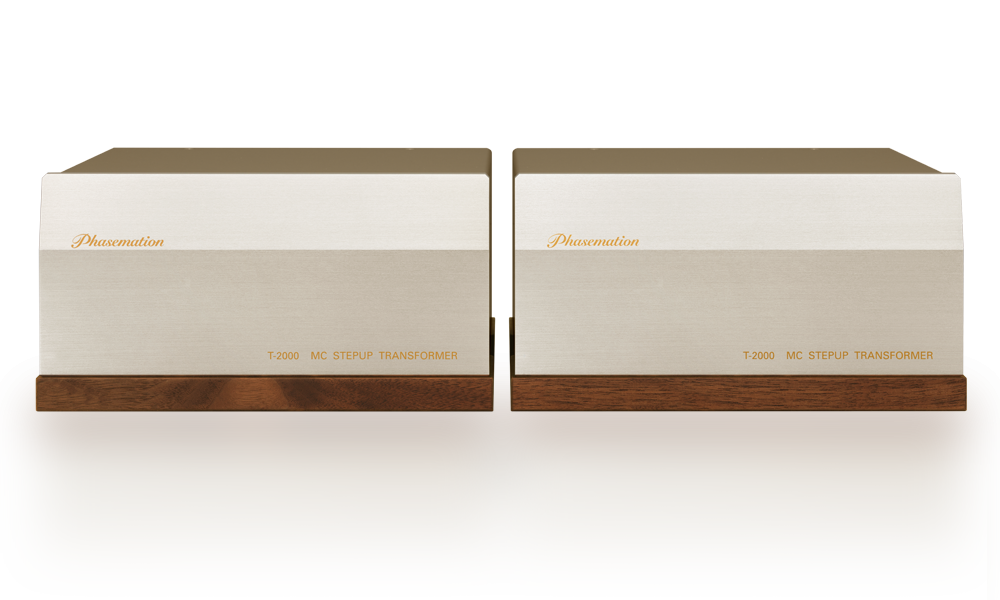

The Phasemation T-2000 is a 2 box step up, which allows a balanced receiving of the cartridge output. They describe the technology of the step up as such:
The basis of wiring at the time of connecting by using a balanced phono cable is shown in Fig. 1. The signal is transmitted from the cartridge coil to the transformer coil through the push-pull balancing circuit and the shield earth covers them. Therefore, the negative effect caused by external noises can be blocked. In addition, the full balanced connection (No.2 pin hot) is structured for the cartridge side by connecting the center of primary coil of transformer to the minus point (signal GND) of the secondary coil.
Plus, we indulged to have it be hand made in order to reach the best sound quality. Due to this, it brought about a superior frequency response and phase characteristic to a wide range and decreased the phase distortion within the hearing range and actualized an even clearer static acoustic image.
A 20mm thick slant aluminum panel is used for the front panel. Below the unit box, a wood base is added and by mixing it with other materials, the unnecessary vibration is effectively removed and brings about a playing sound with a good S/N ratio.
In addition, TA0C high carbon cast iron insulators are adopted for the feet and contributes to the improvement of the sound resolution.
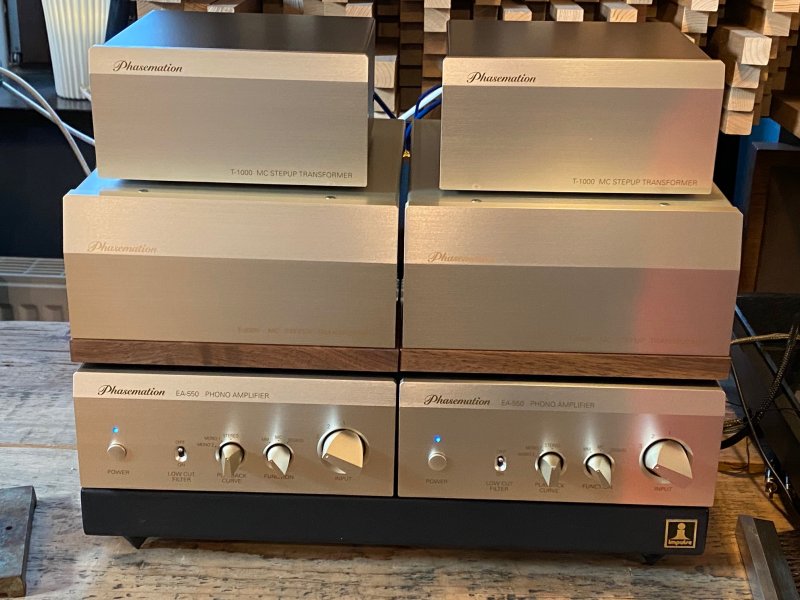
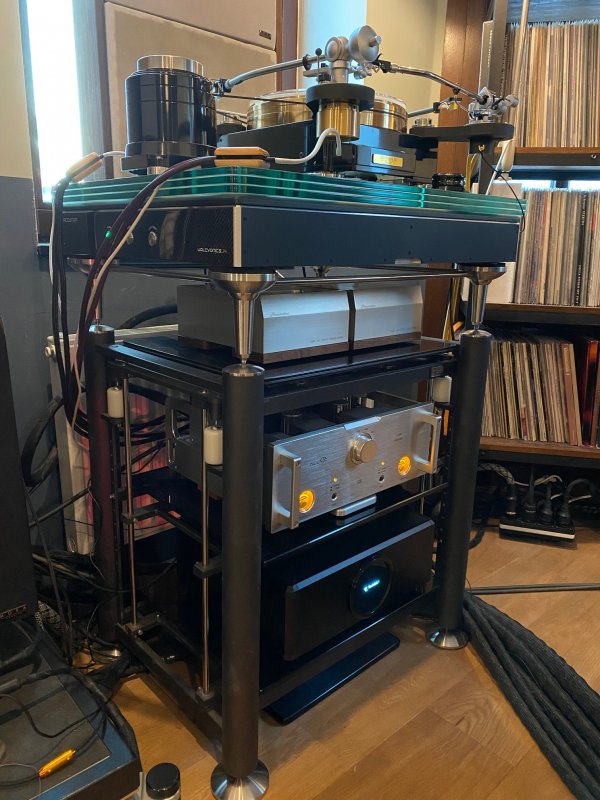
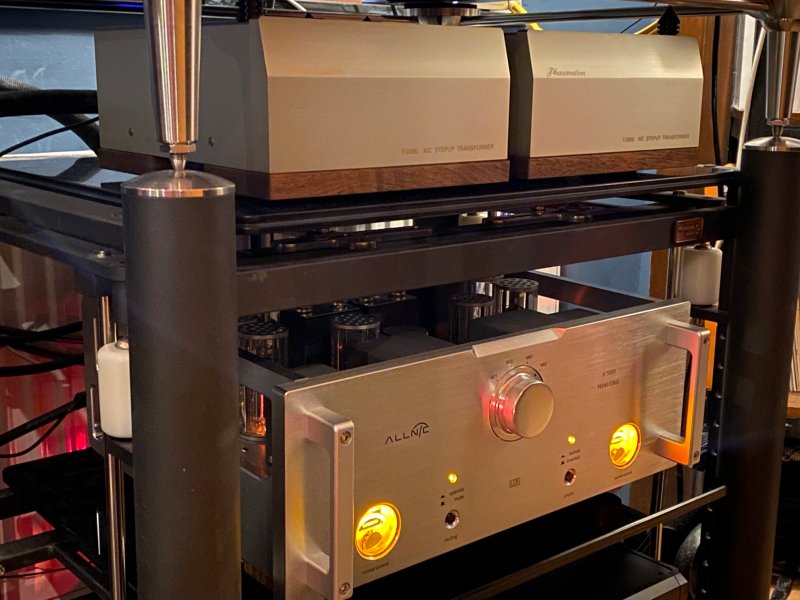
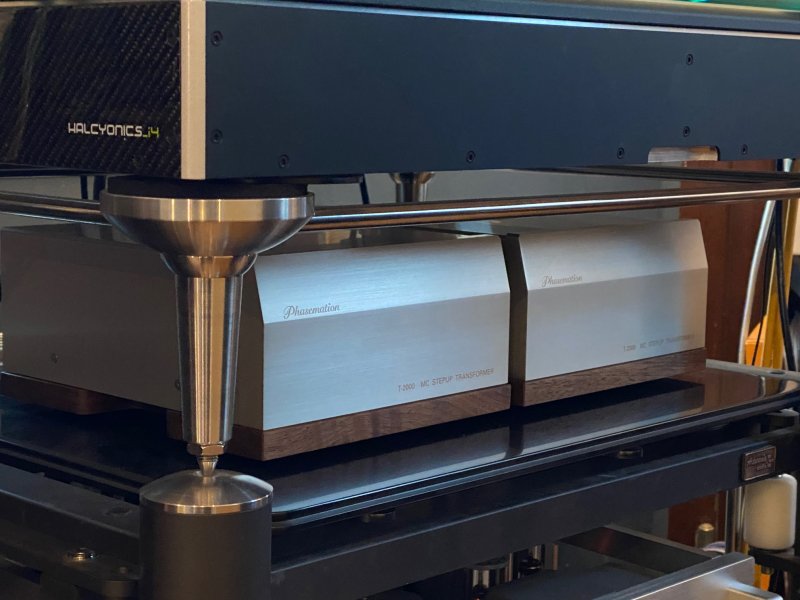
Sometimes my Boulder 2008 Phonopreamp is a combination in heaven (like with JRDG Criterion),
sometime the Boulder 2008 sounds like, that all the Boulder prejudice of lean, dry, analytical..., have come together (like with my current Audionet Stern)
So I started again my journey to the best matching (and for me affordable) Phono Stage.
all the different steps can be found here:
(to "google translate" for all the non German readers)
I did a preselection and finally ended up with a shoot out between
- Boulder 2008
- Allnic H7000v (Kron rectifier)
- Phasemation EA-550
in team with
- Phasemation T-1000 step up
- Phasemation T-2000 step up
The Boulder 2008 had the most details, which was not a surprise, the Allnic H7000v was sweet and nice, but too much information were missing, the Phasemation EA-550 were surprisingly good, if combined with the T-2000 step up. T-1000 was still much better than the internal step ups, but the magic started with T-2000.
As all of the three were not according to my (high) expectations, I paired the Phasemation T-2000 step up with Boulder 2008 and the Allnic H7000v.
(I used Etsuro Cobalt Blue cartridge, Glanz MH-124 Tonearm on TechDAS AF3P turntable)
Connecting the T-2000 to Boulder and Allnic showed, that the magic went with the T-2000 to the other Phonostages. The background noise of the Boulder 2008 was significantly reduced, which help the music to start in a more black background, dynamics were increased and an emotional connection to the music was easily possible (sometimes a real challenge for a Boulder component)
Connecting the Phasemation T-2000 to the Allnic H7000v, the level of information increased, which made it possible to perceive the Allnic more neutral in a positive way.
The Allnic became better in differentiating various records and recordings. With the internal Step Ups I had the feeling, that the Allnic is adding always a little sweet blend to every record.
The internal Allnic Step Up is still good, if I compare to some other Step Ups in my collection, but the Phasemation T-2000 is another level.
Finally I decided to go for the Allnic H7000v plus the Phasemation T-2000 step up as my current main Phonostage.
As I am so convinced with the performance the Phasemation T-2000 has shown, I like to introduce the step up a little further.
Phasemation is not very well known in Europe, only a few markest do have an actively acting Inporter.
I am not sure if Phasemation is well known (even available) in the US.
Phasemation describes their company like this:
"Phasemation" is the hi-fi audio brand of Kyodo Denshi Engineering Co., Ltd.
(Previous "PhaseTech" brand of our company was changed to "Phasemation".)
"Phasemation" is a word created by combining "Phase" and "Information".
Fundamentals of hi-fi audio is to reproduce live music stage by left and right two channels sound. To attain that goal, the phase characteristics between the channels are very important, and that is why we created our brand.
The technological root of our company is to develop and manufacture electronic
measurement instruments. We are an engineering company in pursuit of development for full automation autonomous driving technology, using our core
technology. Therefore, we are in a position to be able to utilize our most advanced technology for development and manufacturing of exquisite hi-fi audio equipments where accurate phase characteristics are required.
The sound that we strive after is reproduction of live music stage in front of the listener as if musicians are playing there, and reproduction of players' pathos and emotions. We believe that realization of such musical reproduction is the goal for the sound created by stereo equipments. To realize our goal, important technical elements such as phase characteristics, circuit technology and vibration control technology are required for the stereo system. Using our technology for all these elements, our ideal stereo system can be created and manufactured.
But, however exquisite the stereo system is, it is not possible to reproduce 100% of original live music. After all, they are just audio equipments. So, we strive to create sound as if artists are playing in front of the listener. To realize it, audio equipment's localization ability of sound sources is very important, and our products are developed and made to maintain accurate phase"


The Phasemation T-2000 is a 2 box step up, which allows a balanced receiving of the cartridge output. They describe the technology of the step up as such:
Balanced Transmission Supported Input Portion
When generating power through a cartridge coil, a balance operation is conducted essentially. Transmitting this signal with an unbalanced connection results in not only the merit of balanced type is damaged or lost, but also external noises directly affects sound quality.The basis of wiring at the time of connecting by using a balanced phono cable is shown in Fig. 1. The signal is transmitted from the cartridge coil to the transformer coil through the push-pull balancing circuit and the shield earth covers them. Therefore, the negative effect caused by external noises can be blocked. In addition, the full balanced connection (No.2 pin hot) is structured for the cartridge side by connecting the center of primary coil of transformer to the minus point (signal GND) of the secondary coil.
Newly developed high performance core materials are adopted.
0.2mm thick permalloy materials which were used previously were reexamined and developed the new "extremely thin super malloy core material." In combination with the large core shape, it reached to have a superior characteristic of very low frequency linearity and high efficiency boosts (low loss) which brings about a detailed atmospheric expression.The adoption of the best coil winding specifications
The transformer coil wiring specifications were reexamined and adopted the best fitting value designing specifications taking into consideration the matching of the transformers and impedance values of the cartridges that are in use. In combination with the new coil winding structure, this brings about a transformer of high resolution and wide ranging of sounds. In addition, due to the adoption of high pure copper wire onto the secondary coil winding, it contributes to have a full sound having a better longevity throughout all ranges.Plus, we indulged to have it be hand made in order to reach the best sound quality. Due to this, it brought about a superior frequency response and phase characteristic to a wide range and decreased the phase distortion within the hearing range and actualized an even clearer static acoustic image.
External induction hums and unnecessary vibration removed
To handle the external induction hums, the chassis base that is a solid steel sheet plated with copper and the case cover with an induction hum shield are used. In addition, it is a double layer structure due to the magnetic shield material which is placed near the transformer. The rising transformer is made of high damping rubber and floats from the main unit and prevents the external vibration from spreading.A 20mm thick slant aluminum panel is used for the front panel. Below the unit box, a wood base is added and by mixing it with other materials, the unnecessary vibration is effectively removed and brings about a playing sound with a good S/N ratio.
High Quality Parts Used
Rhodium plated terminals of FURUTECH products are known for high quality and high sound quality are used for the I/O input terminals.In addition, TA0C high carbon cast iron insulators are adopted for the feet and contributes to the improvement of the sound resolution.
Product Specification
| Best Cartridge's Output Impedance | 4 ohms , The cartridge that can be used has an output impedance of 1.5 – 40 ohms. |
| Load Impedance | 47k ohms |
| Step-up Ratio ( voltage gain ) | 26dB |
| Frequency Response | 10 - 100kHz (±2dB) |
| Dimensions | W : 214mm?H : 118mm?D : 265mm |
| Weight | 4.9kg x2 units |
| Input/Output Terminals | Rhodium plated terminals of FURUTECH |





